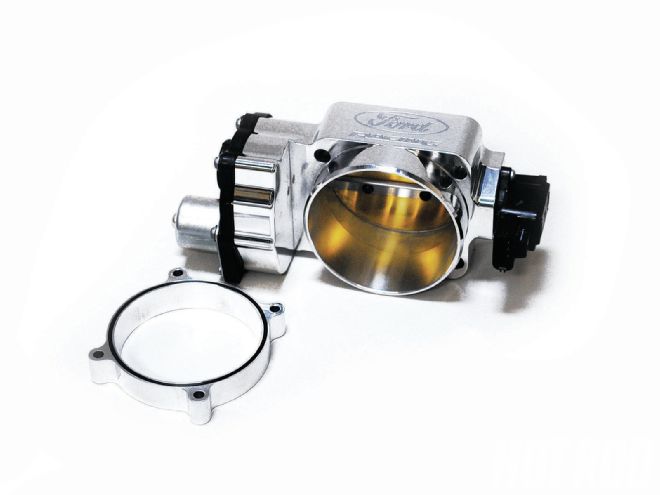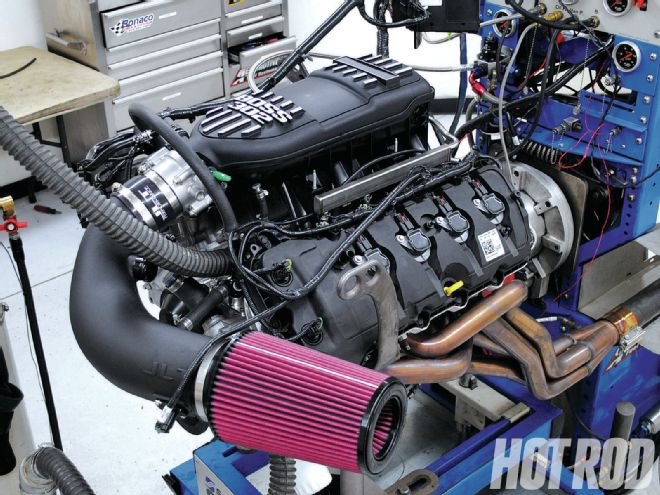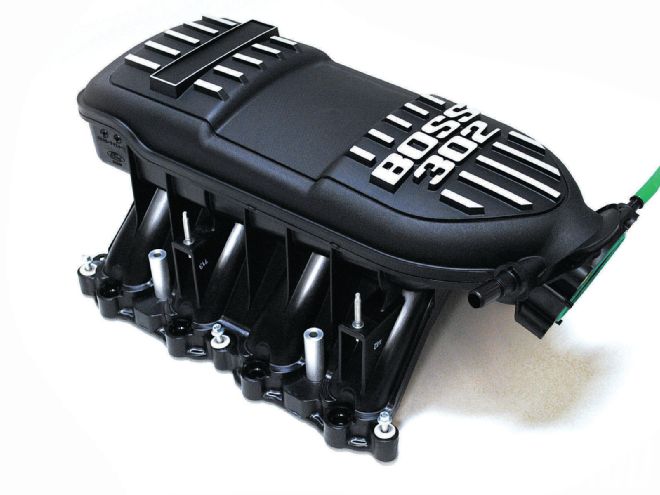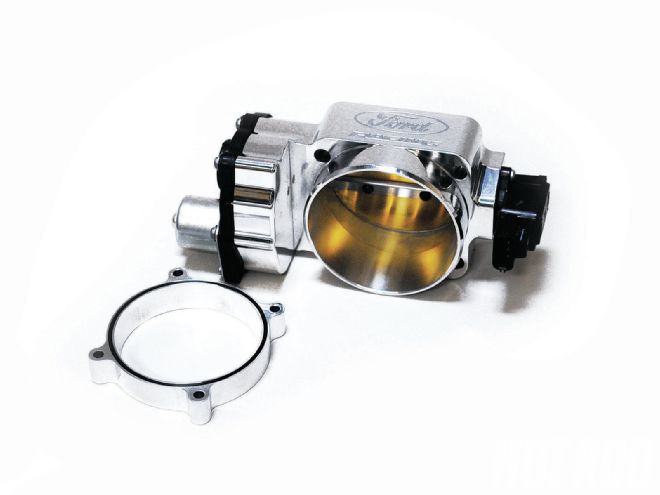
The Premise
 The Ford Racing crate motor was augmented with a JLT air intake, Comp Cams Stage 2 cams, and a set of American Racing Headers. Run with the stock intake, the combination produced 515 hp and 450 lb-ft of torque. Replacing the stock manifold with the Boss 302 intake and Ford Racing throttle-body increased the peak numbers to 540 hp and 435 lb-ft of torque.
The Ford Racing crate motor was augmented with a JLT air intake, Comp Cams Stage 2 cams, and a set of American Racing Headers. Run with the stock intake, the combination produced 515 hp and 450 lb-ft of torque. Replacing the stock manifold with the Boss 302 intake and Ford Racing throttle-body increased the peak numbers to 540 hp and 435 lb-ft of torque.
One of the great things Ford has done recently is create a modern rendition of the original Boss 302 Mustang. Equally impressive is that Ford offers the magical Boss 302 components to the rest of the Mustang crowd, over the counter. Engine-wise, the most prominent component of the new Boss is the composite intake manifold. So, how well does the standard '11-current GT 5.0 engine respond to the so-called "runners-in-a-box" intake design?
The difference between the standard 5.0L Coyote engine and the Boss 302 is more than just an intake manifold, but few owners are willing to tear into their new motor to upgrade to the Boss 302 cylinder heads and revised cam profiles to complete the transformation. Intake swaps on the Coyote are especially easy, as they disturb neither water passages nor a distributor. The swap requires removing a few injector plugs, four bolts for the fuel rail (injectors may be left in place), and six mounting bolts for the intake.
The Stuff
Available directly from Ford Racing or through any of the millions of Ford performance tuners online, the Boss 302 intake (PN M-9424-M50BR) retails for $599.00, but we have seen it for $450.00. The intake can be bolted in place of the stock 5.0L Coyote intake, but we took Ford Racing up on its offer to include a 90mm throttle-body (PN M-9926-M5090) and adapter (PN M-9474-M50B) to neck the throttle-body down to the stock 83mm opening in the Boss (or GT) intake. It is also possible to port-match the opening in the Boss intake to match the larger throttle-body, but we elected to combine the throttle parts in as-delivered trim. The throttle-body lists for $689.00, and the adapter is $56.95. For those installing the intake and/or throttle-body upgrade on a stock 5.0L, Ford offers an installation kit (PN M-9444-M50B, $215) that includes the necessary fuel lines, fuel vapor hose, and air intake tube to properly connect the new intake.
Our testing indicated that it was necessary to revise at least the air/fuel curve to maximize power production with the new intake. Since the Boss intake is tuned for elevated engine speeds, the power curve differed from the production intake, and additional programming was necessary. We relied on an SCT X3 flash programmer both for data-logging and to load the required changes into the factory computer during testing. SCT X3 programmers typically sell for $399.00 online.
 Old-school enthusiasts can liken the
"runners-in-a-box" design of the Boss 302 intake to a tunnel-ram. The design offers a straight shot for the airflow into the impressive four-valve heads. We suspect these manifolds will sell on looks alone.
Old-school enthusiasts can liken the
"runners-in-a-box" design of the Boss 302 intake to a tunnel-ram. The design offers a straight shot for the airflow into the impressive four-valve heads. We suspect these manifolds will sell on looks alone.
The Test
It is unusual to see a new 5.0L Coyote strapped to the engine dyno, but that is exactly where we performed our test. The test engine came courtesy of Ford Racing and included a Controls Pack to allow installation of the motor into an early Mustang or street rod. In addition to an ECU and wiring harness, the Controls Pack included a drive-by-wire throttle pedal, which we attached to the dyno console. The Coyote had been modified in prior testing and included a set of 13?4-inch stainless, long-tube headers from American Racing, a JLT air intake, and a quartet of Stage 2 cams from Comp Cams. The cams were worth an amazing 36 hp over the factory cams, and we figured they would be a good match for the high-winding Boss intake. All testing was performed on the SuperFlow engine dyno at Westech Performance with Ken Christley from Kenne Bell performing the tuning. A working knowledge of the SCT software was critical for repeatable performance. Alterations to ignition timing alone required changes to no less than 32 different tables. Christley was on hand to ensure accurate and repeatable air/fuel, ignition, and cam timing for every run.
The Results
Run in baseline trim with the stock intake manifold, the modified Coyote produced an impressive 515 hp at 6,600 rpm and 450 lb-ft of torque at 5,300 rpm (posting an amazing pump-gas BMEP number of 213). Installation of the Boss 302 intake was simple, and we first ran it with the stock throttle-body and saw 529 hp and 428 lb-ft of torque. The Boss intake offered more peak power but only at the very top of the rev range.
Next we went to run the 90mm throttle-body, but it was not quite a direct bolt-on, requiring us to repin the wiring harness. Ford Racing supplied a revised harness adapter, but unlike on the stock Coyote unit, Ford separated the throttle position sensor and throttle actuator on the billet aluminum throttle-body. In a pinch (we ran out of available dyno time), we ran the larger throttle-body from Ford Racing in manual mode. That entailed removing the stock throttle-body from the intake but keeping it hooked up to the factory wiring harness. That was combined with one person in the dyno cell manually operating the new throttle-body while the dyno operator opened the throttle on the stock throttle-body with the throttle pedal to signal the computer. The Boss intake obviously liked more airflow, as the throttle-body upgrade pushed the peak power output to 540 hp and 435 lb-ft of torque, which is up 25 peak horsepower but down 15 lb-ft of torque from stock.
 The Ford Racing throttle-body upgrade was worth 11 hp on our modified test motor. The 90mm throttle-body includes an adapter to allow installation onto the stock or Boss intake. It is also possible to port-match the opening of the Boss intake to accept the larger throttle-body.
The Ford Racing throttle-body upgrade was worth 11 hp on our modified test motor. The 90mm throttle-body includes an adapter to allow installation onto the stock or Boss intake. It is also possible to port-match the opening of the Boss intake to accept the larger throttle-body.
Conclusions
The Boss intake looks impressive, and we expect many Mustang owners to upgrade their stock Mustangs to Boss status. That the Boss offered a significant power gain at the top of the rev range is simply icing on the cake. It should be noted that the Boss posted better peak horsepower from 6,000 to 7,500 rpm, but the peak torque was down by 15 lb-ft compared with the stock intake.
Bottom Line
The Boss intake is perfect during those times when you will beat on your Mustang in the 5,500 to 7,500 rpm range. Below that point, the factory Ford is one tough cookie.